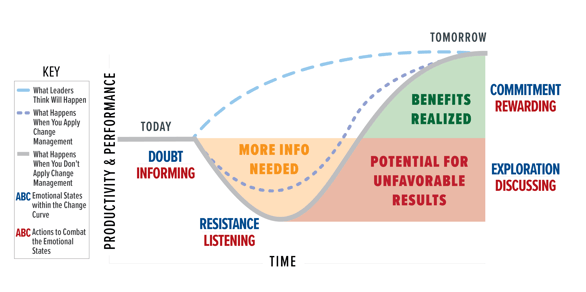Understanding the Emotional Side of Change, Part 1
This two-part blog series by Avaap Senior Consultant, Dr. Brandon Rogers, PMP, PMI-ACP, looks at change initiatives and the need to acknowledge and understand the emotional journey employees face before, during, and after any change initiative.
Part 1: Doubt and Resistance
In today's rapidly changing business landscape, organizations are challenged to find ways to produce products and services with better quality and more efficiency. As leaders, it’s your job to anticipate the challenges, and recognize there will inevitably be changes that have to be made. Whether it is changing an internal process or retiring a legacy technology, changes necessitate a proactive approach to problem-solving while also taking care of your organization's most precious and valuable assets — its employees.
Introducing the Change Curve
 From the time the change is introduced until the time benefits are realized, a great deal of uncertainty exists. When considering your time horizon for implementing change, there’s a delicate balance between the need to maximize productivity and performance and implementing the change.
From the time the change is introduced until the time benefits are realized, a great deal of uncertainty exists. When considering your time horizon for implementing change, there’s a delicate balance between the need to maximize productivity and performance and implementing the change.
Even the strongest of leaders can be paralyzed by uncertainty.
So how do change managers help their leaders and organizations navigate change and guide them through the balancing act?
Managers often ignore the emotional aspects of change because they don't believe they can measure emotion. Ironically, if the people side of change is not considered, an almost immediate dip into business disruption will take place.
The goal of change management is to lessen the curve — to minimize business disruption enroute to the realized benefit of the change. It’s highly unlikely that you will escape change without a dip, but this is one of those times when less is best.
The first two emotional reactions in the curve — doubt and resistance — are powerful emotions that can easily and quickly dismantle your change efforts.
Navigating the Change Curve
Using the Change Curve to understand the emotional states that emerge because of change leads to solutions and strategies that mitigate time spent in the disruption space.
Let’s start with doubt. When doubt presents itself, it is important to provide the change details by informing employees of why the change is taking place and what it means to (and for) them. This can take the form of frequent written and verbal communications with stakeholders at all levels to show the benefit of new ways of working.
Change leaders who host regular, company town-hall meetings, or smaller, more intimate group conversations to allow employees the opportunity to express their concerns create a two-way dialog that serves many purposes, including:
- Helping employees understand the why of the change;
- Demonstrating leadership supports the change; and
- Informing and assisting leaders who listen by giving them direct insights to the top-of-mind issues and concerns employees are focused on.
For change leaders to overcome resistance, you must listen to your people. You will be tempted to jump in and offer solutions to fix, but don’t do this. Your job in these moments is to sit quietly and actively listen so that you understand your employees’ perspective, fears, and anxieties about the proposed change.
Patience is often the key to identifying anticipated threats which can be addressed to further propel the implemented change towards sustainable success.
Next week's post will look at additional elements that should be considered as critical success factors and how to help your organization through change. Companies that are highly effective at change management consider their change initiatives and meaning to employees. Avaap’s market-leading change management approach can help with leadership transitions and restructurings, mergers and acquisitions and any workforce unrest. Come back next week for the conclusion of this interesting topic!

